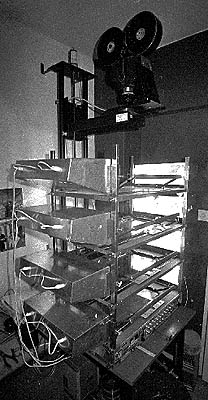Multiplan camera
The multiplan camera or multi-plane camera is an animation camera first developed by Ub Iwerks in 1933 . The backgrounds necessary for a cartoon were drawn on glass plates and then staggered in depth. This created a realistic 3D effect when the camera was moved to the sides, as the parallax shifts the image planes against each other during the movement.
However, this effect alone could also be achieved with several foils placed directly on top of one another, which are offset accordingly between the exposures of the individual images with a fixed camera. The distances for the offset are greatest for the foreground and decrease with increasing apparent distance to a mostly still background.
Because of the high level of effort involved in both methods, one usually limits oneself to one or two action-guiding image levels, since in addition to simulating the spatiality, the individual movement phases of the actors must of course be exchanged. The structure is usually supplemented by a foreground and background level, which are usually not animated themselves, but merely reinforce the impression of spatiality by moving them.
With the Multiplan camera it is also possible to focus on individual image planes with a shallow depth of field in order to emphasize the three-dimensional effect even more. At that time - before the introduction of computer animation - this was the only technically acceptable way of realizing blurred contours in animated films. So-called sharpness zooms can also be implemented, ie the image sharpness “wanders” in a smooth transition, for example from the foreground to a lower-lying image level.
The Disney studios used a multiplan camera developed in-house in 1937 in the short film The Old Mill (1937) and to a large extent in Snow White and the Seven Dwarfs (1937), Pinocchio (1940) and Bambi from 1942.
Web links
- How easy multiplane camera builds (English)
